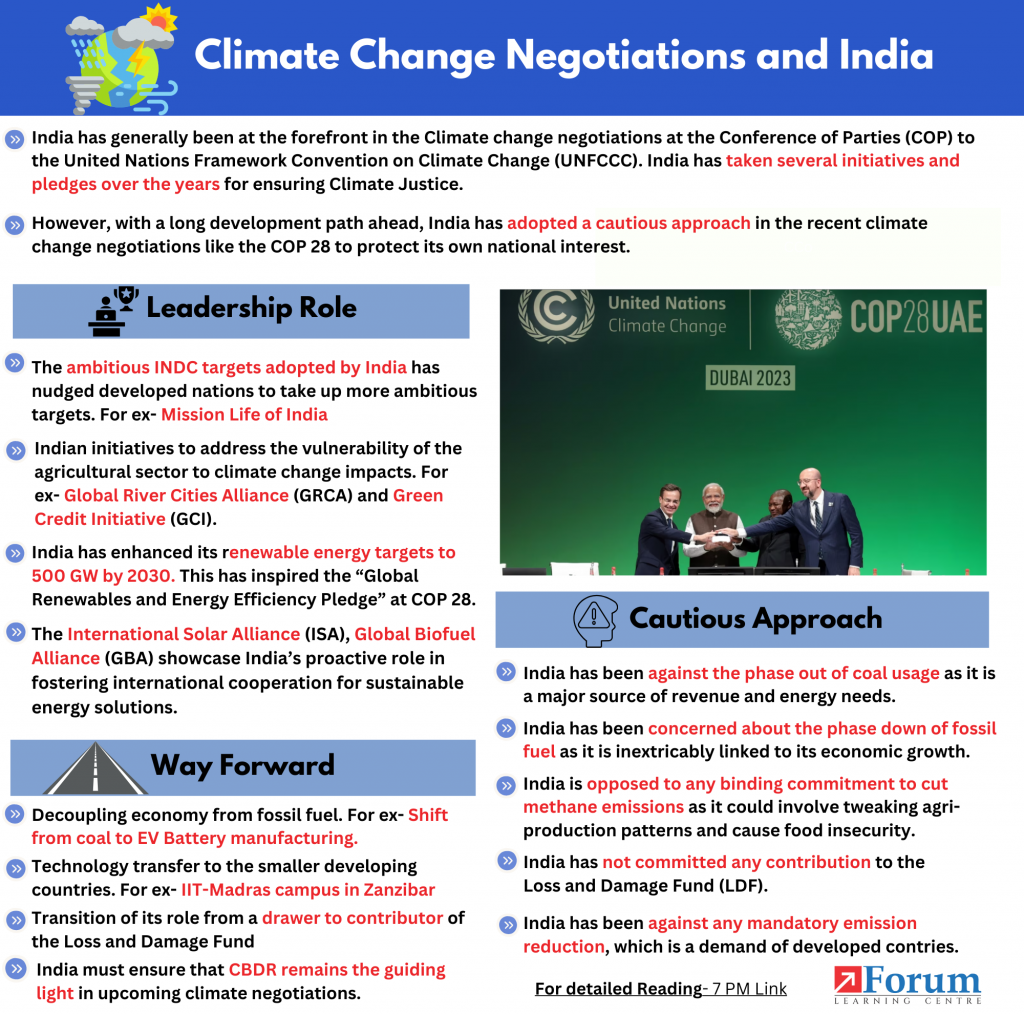ForumIAS announcing GS Foundation Program for UPSC CSE 2025-26 from 19 April. Click Here for more information.
India has generally been at the forefront in the Climate Change negotiations like the Conference of Parties (COP) to the United Nations Framework Convention on Climate Change (UNFCCC). India has also taken several initiatives and pledges over the years for ensuring Climate Justice. However, with a long development path ahead, India has adopted a cautious approach in the recent climate change negotiations at the COP 28 to protect its own national interest.

What has been the positive role of India in the climate change negotiations over the years?
India’s leadership in global climate change negotiations has been marked by a distinctive blend of environmental responsibility and a steadfast commitment to inclusive development. Several tangible examples underscore India’s leadership role in shaping the discourse on climate change-
1. Ambitious INDC targets- India’s Intended Nationally Determined Contributions (INDC) under the Paris Agreement emphasize a reduction in emissions intensity while allowing for economic growth. The ambitious targets adopted by India has nudged developed nations to take up more ambitious targets.
2. Commitment to the Principles of Climate Justice- India has consistently advocated for the principles of “common but differentiated responsibilities, polluters pay principle, compensation for loss and damage” to be the guiding light in all climate change negotiations. India’s stance has aimed for equity in sharing the burden of climate action.
3. Renewable Energy Leadership- Renewable energy, if tripled, has the potential to avoid emissions of about 7 billion tonnes of carbon dioxide equivalent. Recognizing this, India has enhanced its renewable energy targets to 500 GW by 2030, three times of the current renewable energy capacity of 177 GW.
4. Innovative Policy Initiatives- The International Solar Alliance (ISA), Global Biofuel Alliance (GBA), Green Credit Initiative (GCI), showcase India’s proactive role in fostering international cooperation for sustainable energy solutions.
5. Active role in COP Meetings- Through diplomatic efforts at the COPs, India has sought to bridge the gap between developed and developing nations. It has advocated for a consensus on critical issues such as finance, technology transfer, and adaptation. For Ex- Loss and Damage Fund established at COP28.
6. Nudging Pro-Climate Lifestyle- India launched Mission LiFe during COP26 as a global mass movement to nudge individual and community actions to protect and preserve the environment.
What is the inward looking stance of India at the recent Climate Change Negotiations?
1. Against Phase out of Coal- India has been against the policy of phase down of coal usage as it is a major source of revenue and energy needs. The developed countries have proposed that no new coal-fired power plants could be opened without an in-built carbon capture and storage facility. India has opposed the proposal.
2. Phase Down of Fossil Fuel- India has been concerned about the phase down of fossil fuel as it is inextricably linked to its economic growth.
3. Methane emission cuts- India is opposed to any binding commitment to cut methane emissions. Cutting methane emissions could involve tweaking agricultural patterns, which could pose concerns for food security in developing countries like India.
4. Mandatory emission reduction- India has been against any mandatory emission reduction which is being demanded by the developed countries.
5. No Contribution to LDF- India has not committed any contribution to the Loss and Damage Fund (LDF). The expectations of Pacific nations and other vulnerable island countries has been that India, which will soon be a $3 trillion economy, must contribute to the Loss and Damage Fund.
6. Refusal to sign Pledges at COP28- India has not signed The Global Renewables and Energy Efficiency Pledge as well as the Declaration on Climate and Health at the recently concluded COP28. It has claimed that the pledges go against India’s developmental interests by focusing on de-carbonisation of crucial sectors.
| Read More- COP 28 Outcomes and Shortcomings- Explained Pointwise |
What Should be the Way Forward?
India must take up the following route to become the true leader of Climate Change negotiations and actions.
1. Decoupling economy from fossil fuel- India must decouple its economic growth and livelihood from the fossil fuel and coal usage. Alternative employment opportunities must be created in the renewable energy sector. For ex- EV Battery manufacturing.
2. Technology transfer to the smaller developing countries- India must ensure that it is able to transfer its learnings to other economies. For ex- IIT-Madras campus in Zanzibar.
3. Contribution to LDF- India must ensure that it transitions its role from a drawer to contributor of the Loss and Damage Fund.
4. Use of the NDMA expertise- The National Disaster Management Authority (NDMA) expertise can be used for capacity building of the vulnerable island nations and make them climate resilient.
5. Ensure Climate Justice- India must ensure that Common but Differentiated Responsibility (CBDR) remains the guiding light in upcoming climate negotiations.
| Read More- The Hindu UPSC Syllabus- GS III- Conservation, Environmental Pollution and Degradation, Environmental Impact Assessment |




